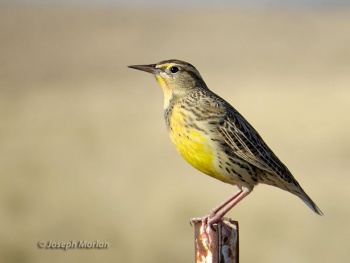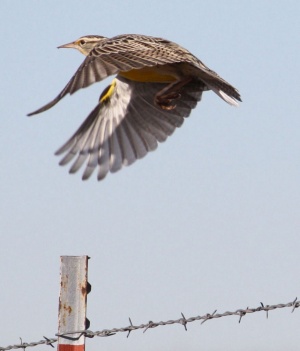- Sturnella neglecta
Identification
Male 21 cm (8¼in); Female 19 cm (7½ in)
- Head striped with light brown and black
- Brown upper parts with black streaks
- Yellow underparts
- Black "V" on breast
- White flanks streaked with black
- Long pointed bill
In fresh plumage the black breast marking may be obscured by pale feather fringing
Similar Species
Eastern Meadowlark: difficult to distinguish the two, except by song and call notes.. The Western has a brownish mottled cheek and yellow extending into the malar area.
Distribution
Western and central North America to southern Mexico. Introduced on the island of Kaua'i, Hawaii.
Taxonomy
Subspecies
This is a polytypic species consisting of two subspecies[1]:
- S. n. confluenta:
- South-western and central British Columbia to western Idaho and southern California
- S. n. neglecta:
- South-eastern British Columbia to northern Baja, Texas and Gulf States
Habitat
Often seen in cultivated fields, but are also to be found in grasslands, prairies, pastures, and abandoned fields.
Behaviour
Breeding
Ground nesters; the nest has a roof woven from grass. There is often a second brood.
Diet
Their main diet consists of insects, such as weevils, grasshoppers and crickets. They also eat seeds and berries.
References
- Clements, J. F., T. S. Schulenberg, M. J. Iliff, D. Roberson, T. A. Fredericks, B. L. Sullivan, and C. L. Wood. 2017. The eBird/Clements checklist of birds of the world: v2017, with updates to August 2017. Downloaded from http://www.birds.cornell.edu/clementschecklist/download/
- Handbook of the Birds of the World Alive (retrieved Dec 2017)
- Wikipedia
- BF Member observations
Recommended Citation
- BirdForum Opus contributors. (2025) Western Meadowlark. In: BirdForum, the forum for wild birds and birding. Retrieved 30 April 2025 from https://www.birdforum.net/opus/Western_Meadowlark
External Links
GSearch checked for 2020 platform.1






